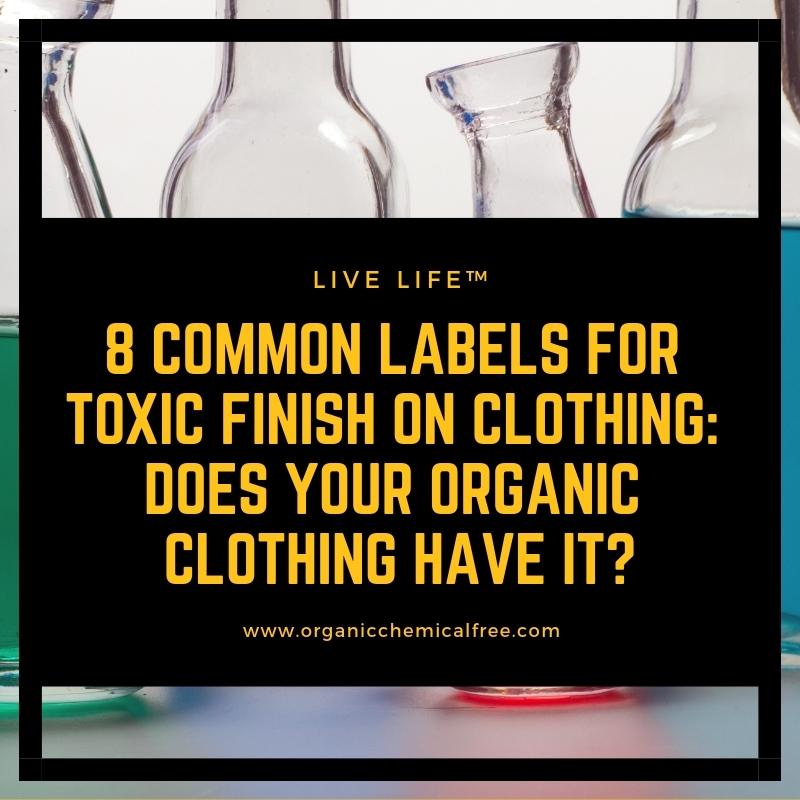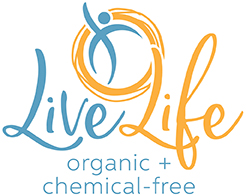
When you buy clothes made of organic clothing, do you assume it’s fully organic?
Or do you wonder, “is there a toxic finish on this clothing”?
It’s a common mistake: thinking that organic cotton or natural wool (and other organic material) is made purely of nontoxic ingredients.
In this article, we’ll explain what is toxic finish, 8 common names for toxic finishes, and the easiest ways to find organic clothing without a toxic finish.
What Is a Toxic Finish on Clothing?
First, things first. What are finishes?
Finishes are applied after the dying process, as one of the last steps in production. It goes: make the material, add dye, and add finish.
These finishes, made with synthetics, are typically referred to as “synthetic finishes.”
Synthetic finishes
Similar to synthetic material, synthetic finishes are made of oil (refined crude oil – from the ground) and man-made chemicals.
Clothing manufactures can use different amounts and types of chemicals as finishes.
With over 8,000 chemicals used in the textile industry, it’s a crapshoot to know which of them ends up in your organic cotton pjs.
Combined in a laboratory, these synthetic finishes are made to stick to clothing material and be the finishing touch.
A toxic finishing touch. :/
These chemicals used to finish clothes (and thousands of other products) have been linked to health conditions – over 140 of them.
Nanoparticles
Some of these chemicals are nanoparticles.
That means they are super duper tiny which makes them easy to absorb into the skin and bloodstream.
From there, they circulate through the body – heart, brain, liver, and all major organs (and cells).
8 Common Labels for Toxic Finishes
There are hundreds of finishes that can be applied to clothing. Most clothing has more than one finish applied.
1. Flame resistant. Children’s sleepwear, pants, shirts, outerwear (coats, hats, gloves), pajamas (kids and adults) to name a few.
2. Water resistant. Mostly seen on coats and gloves, water-resistant clothing keeps the water out.
3. Wrinkle-free. Wrinkle resistant and no iron fall into this category. Dress and casual shirts, khaki pants, dress pants, dresses, skirts are commonly wrinkle free or wrinkle resistant.
4. Pesticides. Since pesticides are sometimes added after production and before shipping, some consider them a finish.
Pesticides are applied to kill bugs, mold, and fungi that can get onto clothing during shipping and when sitting on shelves waiting to be sold.
Pesticides are particularly used when being shipped overseas from other countries. Clothing tags have the country name where the clothing is manufactured. Check your tags to see how much of your clothing is made overseas.
5. Stain resistant. The pictures in this article by Glamour really drive the point of stain resistant home.
Juice BEADS off these clothes – Jeans, dress shirts, and long-sleeve T-shirts, carried by popular companies such as Old Navy, Vardama, Ably, Elizabeth & Clark with price points ranging from $44.94 to $125.00.
How many chemicals are on these clothes? Curious.
6. Antimicrobial. Men’s underwear, socks, workout clothes, and long and short-sleeve shirts come in antibacterial or antimicrobial varieties, marketed to fight bacteria that could grow on shirts (from sweating, leaving it in the washing machine).
Some antimicrobial clothes have silver woven into the fibers. Scientists have found the silver soaks into human skin during workouts, but have not yet concluded if the silver is safe (they’re studying the effects).
These clothes can also be marketed as “anti-odor” label.
7. Antistatic. Formaldehyde can be added to achieve this. Formaldehyde is one of many chemicals in the VOC family.
8. Shrinkage control. Also called “unshrinkable”. Formaldehyde and other chemicals can be used to make clothing unshrinkable.
Are All Finishes Toxic?
Not necessarily.
Smooth finishes can be achieved by weaving the thread a certain way during the manufacturing of the material (vs. adding a chemical finish).
Therefore, checking labels and online product descriptions is helpful.
However, not all clothing labels are transparent.
SOOO many labels do not indicate chemical finishes.
And they don’t have to.
Due to labeling and trade secret laws, companies are not required to list all ingredients in clothing.
In fact, it’s common practice NOT to show the ingredients used to make clothing.
We can turn to marketing labels (vs. the tags) and online descriptions to find more information.
Sometimes, companies will state on the package “wrinkle resistant” or indicate there is little care needed.
And sometimes they don’t…
When labels and marketing (package labels) don’t directly state “no wrinkle” or “water resistant,” it becomes difficult for us common folk consumers to tell which finishes are made of chemicals and which are created from the weave style.
However, there are a few indicators we can watch for.
How Do I Know If My Clothing Has a Toxic Finish?
Here are a few tell-tale signs that toxic chemicals may be in your clothing:
- There is
an odor. If the material smells like chemicals, it very likely has
chemicals. Avoid it. Common statements from my clients include
- smelling like rotten eggs
- sweet smelling
- “smells like chemicals” is one I hear often
However, smell is not a fool-proof method.
Many chemicals do not have a smell to them.
These odors are simply one of the oh-my-gosh moments that might cause you to wonder if chemicals were added.
- Feels “yucky”. Does the material feel stiff or scratchy? It can be an indication there is a finish on the material.
If you don’t feel good wearing it, then don’t.
- Read the online product description. If you’re ordering online you can’t smell or feel the clothing until you receive it. In this case, read the online product descriptions to try to determine if there are chemicals.
I’ll be honest.
Finishes can be one of the trickiest things to avoid in clothing (and other textiles).
What Is The Easiest Way to Find Organic Clothing Without a Toxic Finish?
- Read labels on packaging to determine if there is a finish added.
- Avoid clothing that is “resistant” such as flame resistant, water resistant, wrinkle-free, or stain resistant.
- Use info from credible third-party certifying organizations that are dedicated to looking out for consumer health. This is the best method.
Look for the Global Organic Textile Standard (GOTS) Organic or OEKO-TEX Standard 100 labels. They are the top two most rigorous (listed in order of rigger) certifications in the world.
These labels can be found on clothing packages and in online product descriptions.
For free!
Final Thoughts
When clothing labels say no iron, wrinkle-free, permanent press, and waterproof, leave it on the rack—both in the clothing store and when shopping online.
Toxic finishes are one of several ways clothing can be harmful to health – even on clothing made of organic or natural material.
Here at Live Life, we put your health first, providing credible information to help you create your best organic chemical free lifestyle.
Want more ways to easily find fully organic clothing?
